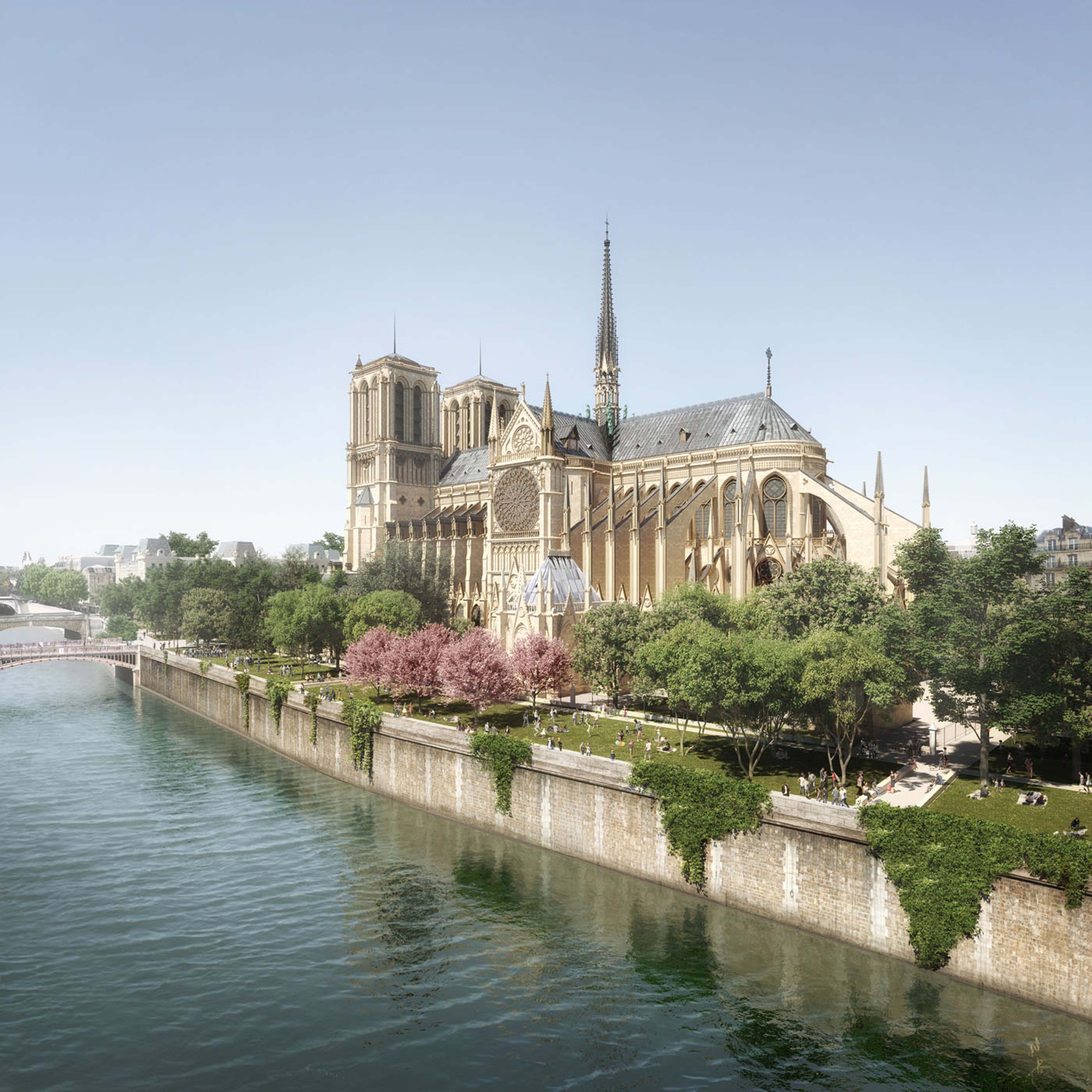Redesign of Notre-Dame Cathedral site will focus on climate resiliency
A redesign of the forecourt at Notre-Dame de Paris will bring trees and climate resiliency to the landscape surrounding the famed Gothic cathedral, which was engulfed by flames in 2019, resulting in the loss of its spire and interiors. A large-scale restoration project ensued, concentrating on reconstructing the tapering steeple and conserving the Parisian landmark’s scorched interiors. The plan for the updated landscape complements the on-going reconstruction of the site.
Brussels-headquartered landscape practice Bureau Bas Smets (BBS) will head the overhaul. The firm was chosen by a jury from a shortlist of four other firms for the redevelopment of the site; the international call for submissions launched in spring 2021. The jury panel was chaired by Paris Mayor Anne Hidalgo, the Public Establishment (the leading conservators of the cathedral’s restoration), and the Diocese of Paris. Citizens and local businesses were also consulted during the competition. The winning design proposal and the others on the shortlist are currently on exhibition at the Pavillon de l’ Arsenal, an architecture and urbanism museum in the 4th arrondissement, until August 28, 2022.

Parisian architecture and urbanism studio GRAU along with local architecture firm Neufville-Gayet will work alongside Bas Smets on the redesign.
With this updated landscape the city hopes to make progress toward the climate goals it has outlined for itself, including temperature control and improved pedestrian and bike access. It responds to the issues and challenges identified during studies surrounding the site; these include mitigating the heat island effect, increasing reception services at the forecourt, and improving the link between the cathedral and the River Seine.
“For 800 years, Notre-Dame has been a privileged witness to the transformation of the city. Rethinking its surroundings means first of all questioning which public spaces for the city of tomorrow,” Bas Smets said in a statement. “The urban figures, such as forecourt, square, square, alignment and banks, are all present around the cathedral, but in a fragmented way. The project reveals the quality of each place and rethinks each of these figures from the double angle of the collective and the climate.”
At the eastern facade of the cathedral, clusters of trees will surround the paved rectangular court to create shaded areas, lowering the temperature of the site. At its perimeter, low-lying ductwork will supply a meager spout of water measuring 0.2 inches high, which will cool the pavers during heatwaves.

In addition to the work on the main facade, the redesign will also focus on the two squares located at the rear of the Notre-Dame de Paris–the Jean XXIII and Île-de-France squares. The fenced-off Jean XXIII Square will be opened up, enlarging the landscape to the edge of the Seine riverbank, and integrating with the gardens on the cathedral’s southside. This lawn will comprise 1,300 square feet and will be planted with 131 new trees. Vegetation coverage across the site will increase by over 35 percent.
A pedestrian walkway will be installed along the rue du Cloître-Notre-Dame, which straddles the cathedral’s edge and the city. This passageway enhances the cathedral’s connection to the city, as part of a larger masterplan working to improve other Parisian neighborhoods.
Beneath the forecourt, at the site of the former subterranean parking garage, an indoor promenade will be installed, greatly reducing the site’s carbon footprint. The 3,229-square-foot interior will house luggage rooms, restrooms, and large group rooms for tourists to convene in. The new space will allow visitor access to tour the archeological crypts with a view out onto the Seine.

The project is entirely funded by the City of Paris and will cost approximately $50 million. The reconstruction of the spire at Notre-Dame Cathedral, which was the subject of much debate among the design community, will be rebuilt to its pre-fire appearance, much to dismay of architects who submitted outlandish designs that proposed rebuilding the spire using glass. How to restore the scorched interiors was also a subject that generated much debate, similar to the spire, they will be reconstructed to replicate their former state.
Despite delays from the Coronavirus pandemic the two large restoration projects hope to complete by 2024 to coincide with the Summer Olympics, hosted in Paris, while the landscape redevelopment plan will not kick off until late 2024, with a goal of completion slated for 2027.

